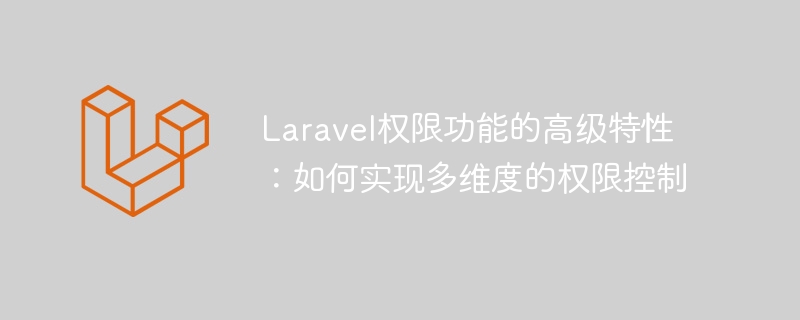

Advanced features of Laravel permission function: How to implement multi-dimensional permission control requires specific code examples
Introduction:
As the business becomes more complex As security increases, permission control plays a vital role in web applications. Laravel, as a popular PHP framework, provides us with powerful and flexible permission functions. In addition to basic role and permission management, Laravel also supports multi-dimensional permission control, which allows fine-grained permission control based on users, roles, resources and operations. This article will introduce how to use Laravel to implement multi-dimensional permission control and give specific code examples.
1. Users and roles
In Laravel, users and roles are the basis of permission control. We can create users and roles through Laravel's own user authentication system, or we can customize user models and role models.
First, we need to create a user table. You can use Laravel's own user authentication system and execute the following command to generate a migration file:
php artisan make:auth
Execute migration:
php artisan migrate
Then, we need to create a role table. You can execute the following command to generate a migration file:
php artisan make:migration create_roles_table --create=roles
In the generated migration file, we add the corresponding fields, such as: name, display_name and description. Then perform the migration:
php artisan migrate
Next, we need to make associations in the user model and role model. Define the roles() method in the user model:
public function roles()
{
return $this->belongsToMany('AppRole');
}Define the users() method in the role model:
public function users()
{
return $this->belongsToMany('AppUser');
}Through the above steps, we have established the relationship between users and roles.
2. Resources and operations
In multi-dimensional permission control, resources and operations are used to describe the scope of permissions we need to control. In Laravel, we can use policies to define resources and operations.
First, we need to create a strategy class. You can execute the following command to generate a policy class:
php artisan make:policy PostPolicy --model=Post
Here, taking the resource model as Post as an example, a policy class named PostPolicy is generated.
In the policy class, we can define common authorization methods, such as view, create, update and delete. For example, to control whether a user can view a post:
public function view(User $user, Post $post)
{
// 可以根据$user和$post的属性进行自定义权限控制
return $user->id === $post->user_id;
} We can also define the default behavior of the authorization method, that is, when no authorization method is defined for an operation, Laravel will call the before of the policy class method. For example, to restrict all users from logging in when deleting posts:
public function before(User $user)
{
if ($user->isAdmin()) {
return true; // 管理员拥有所有权限
}
}Through the above steps, we have created a policy for resources and operations.
3. Multi-dimensional permission control
With the relationship between users and roles, as well as resource and operation strategies, we can achieve multi-dimensional permission control.
First, we need to associate the strategy in the role model. You can add the policies() method in the role model:
public function policies()
{
return $this->belongsToMany('AppPolicy');
}Then, associate the role in the policy model. The roles() method can be added to the policy model:
public function roles()
{
return $this->belongsToMany('AppRole');
}Next, we can perform permission verification in the controller or route. For example, to check if a user has permission to edit a post:
if ($user->can('update', $post)) {
// 用户有权编辑帖子,继续执行
} else {
// 用户无权编辑帖子,返回错误页面
}In this example, the can method verifies permissions based on the user, policy, and resource. Laravel will automatically find the user's role and the role's policy, and then call the corresponding authorization method in the policy to determine the permissions.
4. Code Example
A complete code example is given below to achieve multi-dimensional permission control.
First, create a model named Role and define the roles method in it:
class Role extends Model
{
public function policies()
{
return $this->belongsToMany('AppPolicy');
}
public function users()
{
return $this->belongsToMany('AppUser');
}
}Then, create a model named Policy and define the policies method in it:
class Policy extends Model
{
public function roles()
{
return $this->belongsToMany('AppRole');
}
}Next, we can perform permission verification in the controller:
class PostController extends Controller
{
public function update(Request $request, Post $post)
{
$this->authorize('update', $post);
// 继续执行更新操作
}
}In this example, we use the authorize method to perform permission verification. Laravel will automatically find the corresponding policy based on the user and resource, and call the corresponding authorization method in the policy.
Conclusion:
Laravel’s permission function provides flexible and powerful multi-dimensional permission control, which can meet various complex business needs. Through user and role association, resource and operation policies, we can achieve fine-grained, multi-dimensional permission control. I hope this article can help readers understand and apply Laravel permission functions and improve the security and maintainability of web applications.
The above is the detailed content of Advanced features of Laravel permission function: how to implement multi-dimensional permission control. For more information, please follow other related articles on the PHP Chinese website!




